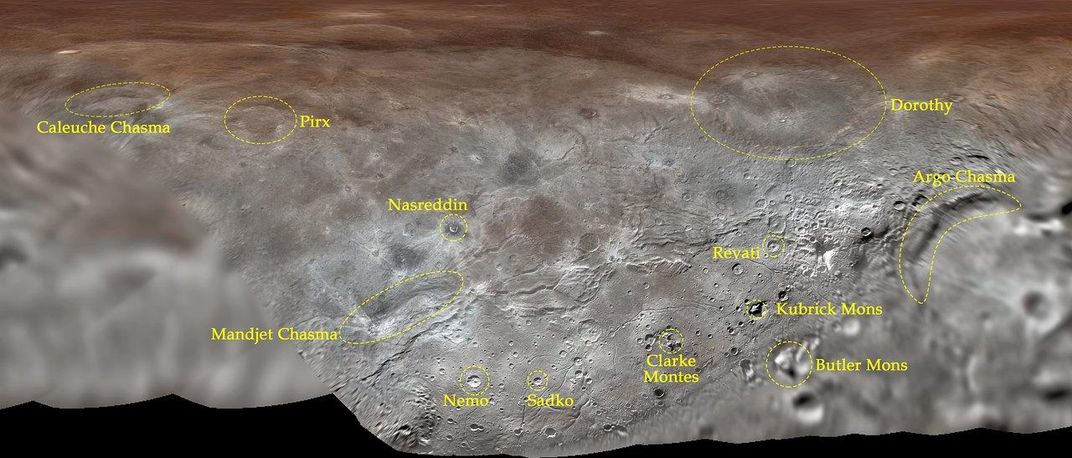Sci-Fi and Snakes Rule in New Official Names for Features on Pluto’s Largest Moon and Mercury
Stanley Kubrick and Octavia Butler are among the figures honored
/https://tf-cmsv2-smithsonianmag-media.s3.amazonaws.com/filer/d6/8e/d68e2d6b-2f6b-431f-a7b2-115109c83ca4/mercury_faculae.png)
With each new missions into space, we get spectacular views of stars, asteroids, planets and more. And with each discovery of crater and mountain on these far-flung worlds, researchers need identifying names.
That's where the International Astronomical Union (IAU) comes in. They're the ones responsible for regulating the assignment of space names. And recently, the IAU Working Group for Planetary System Nomenclature announced two new sets of names for the cosmic roster: Mercury’s so-called “red spots” and a dozen features on Pluto’s largest moon, Charon.
As Deborah Byrd reports for EarthSky, the valleys, crevices, craters and other features found on Charon have been named after figures in literature and mythology and includes legendary explorers and visionaries, both real and imaginary.
Ahead of NASA’s historic flyby of Pluto in 2015, the agency invited the public to propose names for the features of Pluto and Charon. More than 40,000 submissions poured in, and the New Horizons team sorted through the options before making their recommendations to the IAU, which gives the final approval to make the names official.
The group started giving final approval for names of Pluto's features last year. And now, 12 Charon features were named, according to a press release. They include:
-
Butler Mons, named after Octavia E. Butler, the first science fiction writer to win a MacArthur fellowship
-
Caleuche Chasma, named after a mythological ghost ship that is said to travel around a small island off the coast of Chile, collecting the dead
-
Clarke Montes, honoring science fiction writer Sir Arthur C. Clarke, who is best know for his work 2001: A Space Odyssey
-
Kubrick Mons, after film director, screenwriter and producer Stanley Kubrick
-
Mandjet Chasma, named after a boat in Egyptian mythology responsible for transport of the sun god Ra across the sky—it's among the earliest mythological examples of a vessel that traveled to space
-
Nemo Crater, named after the captain of the Nautilus submarine in Jules Verne’s novels Twenty Thousand Leagues Under the Sea (1870) and The Mysterious Island (1874)
-
Sadko Crater, named after the fictional character in "Bylina," a medieval Russian narrative poem, who traveled to the bottom of the sea
As John Timmer reports for Ars Technica, Charon is one of the largest bodies in the Kuiper Belt, and there are still plenty of informally named features yet to be officially named.

But Charon isn't the only one getting it's time in the spotlight. Earlier this month, seven “red spots” spread out across Mercury's dark gray surface also got official names, Nola Taylor Redd reports for Science.
Researchers first noticed Mercury's spots in 2008 when the MErcury Surface, Space ENvironment, GEochemistry, and Ranging spacecraft (or MESSENGER) made its historic visit to the tiny world. As it zipped past, the craft captured images from as close as 124 miles above the heavily cratered, rocky surface.
Scientifically known as faculae, which is any bright spot on the surface of a body, the seven features bare the word for “snake” in different languages. According to Redd, the spots don’t look have a snake-like appearance. Rather, Mercury, the Roman god of merchants and finance, often appears with snakes in mythology.
Four of the faculae have names originating from African languages of Somalian, Igbo (of southeastern Nigeria), Arabic and Afrikaans. The others names are Irish, Welsh and Basque.
The bright spots are thought to be pyroclastic ash linked to ancient explosive volcanism that lasted billions of years, Charles Q. Choi wrote for Space.com in 2014.